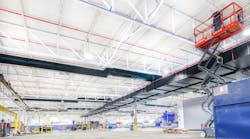The past few years have marked a dramatic shift in priorities for businesses operating within the industrial sector. Not only has employee safety become increasingly more important, but growing pressure to achieve sustainability goals have come to the forefront, bringing new decision-makers into the purchasing process to ensure that long-term value, product performance, and corporate social responsibility are not sacrificed for a cheaper upfront cost.
While in the past industrial decision-makers might have overlooked lighting as a key driver of these objectives, that is starting to change, owing to more advancements and research regarding lighting’s direct impact on plant safety, energy efficiency, decarbonization, cost savings and its emerging potential in offering functionality and data beyond illumination. In 2024, we expect industrial leaders to place a premium on the features and measurements that will de-risk their organizations, increase capital investment and ensure the impact of switching from antiquated legacy lighting to alternative solutions like LEDs will deliver on their needs over the long-term. Here are the four main trends shaping these actions in 2024.
1. Employee Safety Above All
Industrial worksites are among the most dangerous places to operate, with injury and illness cases in 2022 alone up 7.5%. Often subject to challenging environmental conditions, such as extreme temperatures, debris, unstable power, and high vibrations, these elements can rapidly destroy electrical equipment, including lighting. Without adequate visibility, employees are at a significantly higher risk of slips, trips and falls, all of which have long been cited by the Occupational Safety and Health Administration (OSHA) as among the top safety offenders.
Simply put, reliable lighting is a non-negotiable, and only high quality, industrial-grade LED lighting can withstand the harsh conditions that are present at these sites. In 2024, industrial-grade fixtures will offer even more advanced protections to ensure they perform optimally over their lifespan. One example of such innovation includes broader commercial availability of volatile-organic-compound (VOC) chemical shields - a specialized coating that protects LED diodes from chemical attacks. VOCs can distort lighting, causing abnormal color shifts and reduced visibility over time. Additionally, lighting manufacturers will introduce more options featuring low glare and high CRI illumination to improve employee alertness, productivity, and overall satisfaction.
2. Increased Demand for Quality, Reliability, and Longevity
Forward-looking decision-makers know the true cost of lighting extends far beyond the initial purchase order and installation, encompassing ongoing maintenance costs for both parts and labor. There are also other significant costs accrued from lengthy plant downtime and specialized equipment rentals for conducting such challenging maintenance.
LED lighting offers a major advantage as they require little to no maintenance for five times longer than legacy lighting systems and at least twice that of lesser quality LED solutions. Reputable manufacturers will offer warranties of at least ten years, even going the extra step of having their warranty validated by accredited third parties, such as the National Lighting Bureau. This is in addition to extensive pre-market validation testing to ensure the products will work as promised. A simple paper warranty offering replacement for failing fixtures without evidence of extensive premarket testing and externally verified warranties will cost organizations thousands, especially when unplanned labor and lost productivity are added on.
3. Advances in Emergency Battery Backup Systems
As previously mentioned, the harsh conditions at industrial work sites can wreak havoc on lighting and instantly plunge areas into darkness when failures occur. Building codes and safety regulations often mandate the installation of backup and emergency lighting systems to offer safe egress should an outage occur. Advances in auxiliary battery technology including lighter weight, lower profile, and more cost-effective systems will make installation and ongoing diagnostic testing without the need to push for indicators or additional wiring even more convenient. With these features, battery backup solutions become more broadly accessible for all industrial sites, including chemical plants, oil rigs and other hazardous locations. In the new year, these options will continue to be upgraded with the ability to be retrofit into existing infrastructure, significantly reducing installation time and cost.
4. Regulations and Emerging Tech Will Make Lighting Future-Proof
Over the past year, new regulations targeting antiquated and dangerous lighting products have started to take effect across the globe and are expected to ramp even more over the next few years. Due to its toxic contents, lower output and electrical inefficiency, traditional lighting sources including fluorescent and HID lights are being phased out globally. Production and sales of incandescent light bulbs have already been banned by the U.S. Department of Energy, while manufacturing and importing most mercury-containing lamps have been blocked in Canada. In the UK, there are upcoming changes to minimum efficacy requirements, with the minimum allowable lumens per watt set to increase from the current 120 lm/W to 140 lm/W by September 2027. With these changes, the purchasing and storing of legacy bulbs and ballasts have become a risky investment. Depending on the location, facilities might be eligible for tax incentives or could incur penalties for noncompliance, making the adoption of sustainable equipment even more appealing to industrial leaders.
In addition to designing fixtures for long life and without toxic chemicals, lighting manufacturers are exploring new materials, such as polymers, that have lower global warming potential. Polymeric material housing seeks to reduce fixture size and weight, improve thermal performance, and reduce material costs, all while improving product toughness and durability.
Last but not least, industrial lighting infrastructure with LEDs has the potential to push beyond simple illumination to offer data, insights, and functionality, catapulting site safety and productivity in never-before-seen ways. Emerging technologies, including the integration of power electronics into software-based platforms and building automation, will add to lighting’s capabilities in providing advanced safety and productivity functionality via sensors and other accessories. The utilization of digital twins for maintenance ease, real-time insights into power quality and environmental stressors are just a few ways that lighting software can add even greater value. These new software-based functionalities will make lighting adaptable, allowing new features and functionality to be unlocked over time.
With all of these advancements coming to the forefront, 2024 is the time for businesses who have considered upgrading to industrial LED lighting to make the switch. LED lighting has quickly become one of the most effective and affordable ways to achieve both safety and sustainability objectives, with widespread and growing adoption across nearly every industrial sector.




